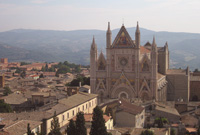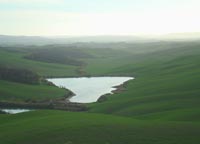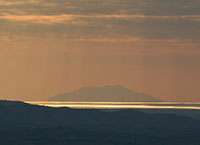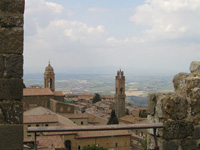| |
|
| |
|
|
|
|
|
|
| |
 |
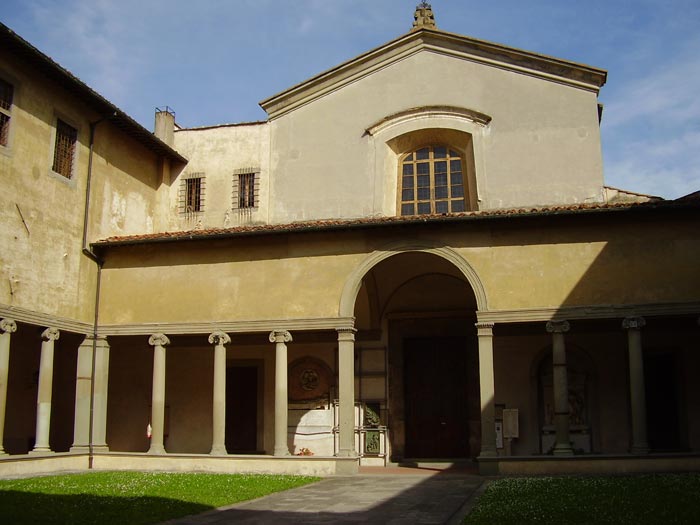 |
| |
Santa Maria Maddalena dei Pazzi, the entrance with the portico
|
|
 |
 |
| |
|
|
|
| |
|
Tuscany Travel Guide | Art in Florence | Santa Maria Maddalena dei Pazzi
|
|
|
|
| |
|
| Santa Maria Maddalena dei Pazzi is a religious complex in central Florence, Italy, including a church and a former convent in Borgo Pinti.
The Pazzi name was added after a Carmelite nun, canonized in 1669, from the Pazzi family, who patronized the church. The original convent had been dedicated to St. Mary Magdalen delle Convertite, the patron of once-fallen, now "converted" women. The Cistercian order from Badia a Settimo took control of the site in 1332, and moved here in 1442, while the convent was transeferred to San Donato in Polverosa. However the church and chapter house were rebuilt between 1481-1500, with initial designs in 1492 by Giuliano da Sangallo. The 13th-century interiors were redecorated in the 17th and early 18th centuries, which removed prior altarpieces by masters such as Botticelli, Perugino, Lorenzo di Credi, Domenico Ghirlandaio, and Raffaellino del Garbo. They were replaced by new ones, by minor masters such as Carlo Portelli, Alfonso Boschi, Domenico Puligo, Santi di Tito, and Francesco Curradi. In the chapter house is a fresco divided into three lunettes of the Crucifixion and Saints (1493-96) by Pietro Perugino, commissioned by Dionisio and Giovanna Pucci.[1]
The first chapel to the right of the entrance is the Cappella del Giglio (Chapel of St. Mary of the Lily) frescoed with depictions of Saints Filippo Neri, Bernard, Nereo, and Achilleo by the studio of Bernardino Poccetti with an altarpiece by Domenico Passignano. The fourth chapel on the right has a stained glass window by Isabella, the daughter of Georges Henri Rouault. The choir chapel originally contained a fresco by Domenico Ghirlandaio, but was rebuilt in 1685-1701 by Ciro Ferri and Pier Francesco Silvani. Ferri painted the altarpiece and Luca Giordano the flanking pieces. The statues of Penitence and Faith on the right were sculpted by Innocenzo Spinazzi, while Innocence and Religion on the left by Giovanni Monatauti. The bronze reliefs on the altar were made by Massimiliano Soldani-Benzi.
The interior also contains works by Giovanni and Cosimo Bizzelli, Jacopo Chiavistelli, Ottavio Vannini, Cosimo Rosselli, Cosimo Gamberucci, Leonardo del Tasso, Giuseppe Servolini, and Giuseppe Piattoli among others. |
|
|
|
| |
|
The Pazzi Crucifixion, Pietro Perugino
|
|
Pietro Perugino, The Pazzi Crucifixion, 1494-96, resco, S. Maria Maddalena dei Pazzi, Florence
|
|
The conventual complex, dedicated to the Florentine Carmelite St Maria Maddalena de’ Pazzi, who had such an influence on 17th-century spirituality, was originally founded in 1257 and dedicated to St Mary Magdalen ‘delle Convertite’, in a place where there was already a house for ‘penitent’ (or ‘converted’) women who followed the Rule of St Benedict.
The Cistercians from Badia a Settimo, who took over control of the convent in 1322, moved here in 1442, at the invitation of Pope Eugenius IV who sent the Convertite away to San Donato in Polverosa.
The convent in Borgo Pinti was rebuilt between 1481 and 1500; paid for by Bartolomeo Scala, it was designed by Giuliano da Sangallo, who devised the innovatory Ionic porticoed quadrangle in front of the church.
The aisle-less interior has six deep chapels on each side of the nave, in white plaster with beautiful carved arches in grey pietra serena, and was harmoniously decorated between 1480 and 1530 with altarpieces by artists such as Botticelli, Perugino, Lorenzo di Credi, Domenico and Ridolfo del Ghirlandaio, and Raffaellino del Garbo, which unfortunately were moved elsewhere during the rearrangements of the 17th and 18th century. They were replaced by new ones, by minor masters such as Carlo Portelli, Alfonso Boschi, Domenico Puligo, Giovanni Bizzelli, Santi di Tito, and Francesco Curradi.
The monumental fresco of the Crucifixion, painted by Pietro Perugino in 1493-1496 and commissioned by Dionisio and Giovanna Pucci, members of two aristocratic Florentine families.
The decoration takes up a whole wall, divided by the ceiling vaults and the painted architectural arch elements. The harmonious and luminous scenery contributes to decreasing the emphasis of the drama represented by the scene, that reflects the typical serene and meditative attitude of the artist. The fresco portrays the Virgin Mary and John the Baptist, at the foot of the cross. The other personalities were chosen because they had a very special meaning for the monks living in this convent.
“Maddalena” is the saint to which the church was originally dedicated in 1257; St. Benedict is the father of western monachism, while Bernard de Clairvaux (represented in a white garment) is the famous theologian of the early years of the Cistercian order. The three trees with slim trunks and thick foliage behind the figure of St. Bernard are perhaps a symbol of Trinity.
A century later, Bernardino Poccetti frescoed the Chapel of St Mary of the Lily, to the right of the entrance to the complex.
|
|
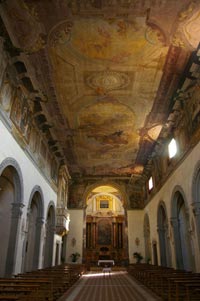 Santa Maria Maddalena dei Pazzi, interior |
The Jacopi Chapel, begun in 1489, was acquired in 1503 by Giovanni di Bernardo Jacopi. The arms of Jacopi and those of his wife (of the Serristori family) are sculpted on the capitals of the chapel.
Giovanni Jacopi’s coat of arms, a black wild boar on a gold shield, is also at the center stained glass windows.
The windows are composed of bull’s eyes of colorless glass linked by rhomboid, colored glass pieces which are decorated with painted flowers.
This type of window belongs to a what was apparently a Renaissance liking for displaying heraldry in Tuscan stained glass windows. Actually, though this window bears some resemblance to the one in the Riccialbani window on the north side of the church (see Firenze S. Maria Maddalena de’ Pazzi 4), it differs from it considerably due to its unusual border: it is composed of small hexagons painted with animated animals. This type of repertory is not usual in stained glass practice. Rather, it is typical of illuminated manuscripts. (Such animal motifs appear, for example, in Zanobi Strozzi’s "libri d’ore"). The glazier’s familiarity with the miniaturist’s art seems to indicate that he was active in a multi-purpose workshop, such as that of the Gesuati. [3]
|
|
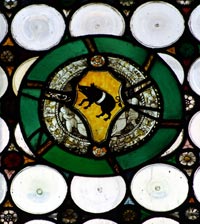 |
Churches in Florence
|
|
| View Firenze churches in a larger map |
Map of the churches of Florence, Italy |
Tuscany | Churches, cathedrals, basilicas and monasteries of Florence, Italy
|
|
|
|
|
| |
|

|
|
|
| [1] Perugino (b Citta della Pieve, c. 1450; d Fontignano, ?Feb 1523) was an Italian painter and draughtsman. He was active in Perugia, Florence and Rome in the late 15th century and early 16th. Although he is now known mainly as the teacher of Raphael, he made a significant contribution to the development of painting from the style of the Early Renaissance to the High Renaissance. The compositional model he introduced, combining the Florentine figural style with an Umbrian use of structure and space, was taken up by Raphael and became widely influential throughout Europe. |
|
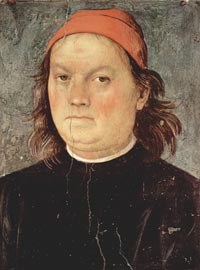 Pietro Perugino, Self-portrait, 1497–1500,
Collegio del Cambio, Perugia. |
[2] The fresco is much repainted. It was begun in 1493 at the commission of Dionisio Pucci,
and was finished 1496. The Pucci family was a major political family in Florence. The first Pucci family members to be mentioned date to the 13th century with their subscribing to the Arte dei Legnaioli. These early members include Antonio Pucci, who worked as an architect on the construction of the Loggia della Signoria. His son Puccio Pucci was a merchant who became rich thanks to trade and financial activities in medieval Florence. The first Pucci residences were in the Santa Croce district of Florence, before they moved to that of the church of San Michele Visdomini.
Members of the Pucci family, a major Florentine political familywere Antonio di Puccio Pucci (circa 1350–1416), Florentine politician and architect; Puccio Pucci (politician) (1389–1449), Florentine politician, son of Antonio; Lorenzo Pucci (1458–1531), Italian cardinal; Roberto Pucci (1462–1547), Italian cardinal; Antonio Pucci (cardinal) (1485–1544), Italian cardinal; Francesco Pucci (politician) (Florence 1437 - 1518), Florentine politician; Pandolfo Pucci (died 2 January 1560), responsible for the Pucci plot, and Orazio Roberto Pucci (Florence, 1625–1698), first Marchese di Barsento.
Antonio di Puccio Pucci (c. 1350 – after 1416) was an Italian architect and politician from the Pucci family. In 1404 he bought the chapel of San Sebastiano in church of Santissima Annunziata in Florence from the Servites, with the unusual condition in the acquisition contract that the Servites were required to invite the two senior members of the Pucci family to dinner on every Saint Sebastian's day (20 January).
In 1404 Antonio di Puccio Pucci acquired the chapel of San Sebastiano in the church of Santissima Annunziata, in which he placed the precious Piero del Pollaiolo painting of the Martyrdom of Saint Sebastian (now in the National Gallery, London). Puccio Pucci bought the Cappella della Madonna del Soccorso a few decades later.
The family palazzo still contains one of the four paintings commissioned by Lorenzo the Magnificent from Sandro Botticelli as a gift to Giannozzo Pucci on Giannozzo's marriage to Lucrezia Bini in 1483. These paintings tell the story of Nastalgio degli Onesti and the first three in the narrative are now in the Prado in Madrid. The painting still in Florence shows the use of forks, which were traditionally adopted for the first time in Florence by the Pucci and whosa use Catherine de'Medici then spread right across Europe. It also shows the use of precious tableware and silver vessels, which really existed and were said to be from the workshops of Verrocchio and Pollaiolo.
The Pucci commissioned several works for the churches neighbouring their palazzo. For the church of San Michele Visdomini, in 1518 Francesco Pucci commissioned Pontormo to paint the Holy family with saints, which was described by Vasari as one of the best paintings by an empolese painter. Whilst he was archbishop of Bologna, cardinal Antonio Pucci commissioned Raphael to paint a scene of The Ecstacy of Saint Cecilia - still in Bologna, it is now at the city's Pinacoteca. At the end of te 16th century Lorenzo Pucci commissioned Alessandro Allori to paint a Marriage at Cana as an altarpiece for the church of Sant'Agata (completed 1600).
In the 16th century, in one of the most beautiful areas of the hills around Florence, abbot Alessandro Pucci had a villa built for himself which in its structure would fully represent the mannerist ideal in vogue at the time. In addition to the villa, which was originally completely frescoed inside and out, a garden was also laid out and an extensive park with beautiful trees and sculptures of animals dotted in amongst. These grounds were designed by Tribolo. In 1906 the villa was purchased by the world-famous Italian tenor Enrico Caruso who, totally enamoured of the beauty and peace his new home offered, arranged for the villa to be restructured, restored and embellished with works of art. As a result of the work done the villa acquired the appearance it retains to this day. Since 1955 the villa, garden, park and farm have been owned by the town of Lastra a Signa. It is run by the Villa Caruso Association, which organises concerts and other performances, exhibitions and visits.
|
|
[3] Toscana Firenze | C. di S. Maria Maddalena de’ Pazzi
|
|
|
|
|
|
|
 |
Orvieto, Duomo |
|
Crete Senesi, surroundings
of Podere Santa Pia |
|
Florence, Duomo Santa Maria del Fiore |
| |
|
|
|
|

The sixteenth century Villa di Bellosguardo | www.villacaruso.it
Bibliography
Damien Wigny, Au coeur de Florence : Itinéraires, monuments, lectures, 1990
|
|
This article incorporates material from the Wikipedia article Santa Maria Maddalena dei Pazzi published under the GNU Free Documentation License.
Wikimedia Commons has media related to Chiesa di Santa Maria Maddalena dei Pazzi.
|

Tuscan Holiday houses | Podere Santa Pia
|
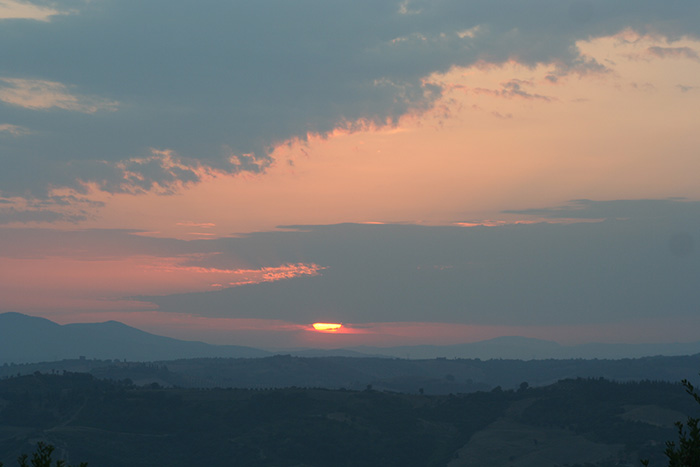 |
Podere Santa Pia, with a stunning view over the Maremma and Montecristo
|
| |
|
|
|
|
|
|
|
|
|
|
Podere Santa Pia |
|
Podere Santa Pia, garden |
|
Montecristo, view from Santa Pia
|
 |
|
|
|
|
Sant'Antimo, between Santa Pia and Montalcino |
|
Pienza |
|
Montalcino |
| |
|
|
|
|
| |
|
|
|
|
|
|
| |
|
|
|
| |
|
|
|
| |
|
|
|
| |
|
|
|
| |
|
|
|
| |
|
|
|
![]()
![]()
![]()
![]()
![]()





 Pietro Perugino, Self-portrait, 1497–1500,
Pietro Perugino, Self-portrait, 1497–1500,